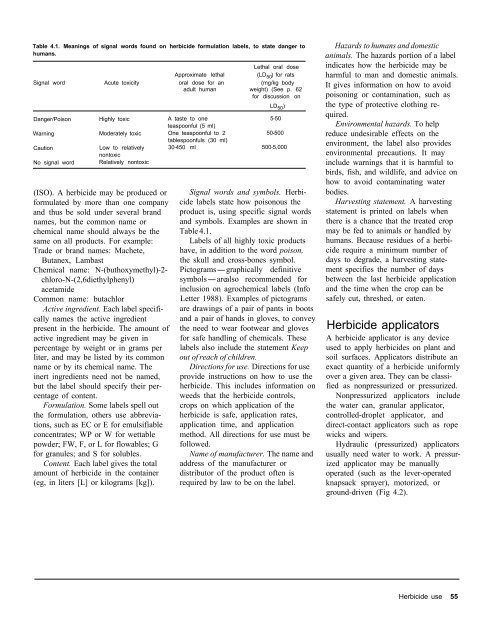A handbbok on Weed Control in Rice.pdf
A handbbok on Weed Control in Rice.pdf
A handbbok on Weed Control in Rice.pdf
You also want an ePaper? Increase the reach of your titles
YUMPU automatically turns print PDFs into web optimized ePapers that Google loves.
Table 4.1. Mean<strong>in</strong>gs of signal words found <strong>on</strong> herbicide formulati<strong>on</strong> labels, to state danger to<br />
humans.<br />
Lethal oral dose<br />
Approximate lethal (LD 50 ) for rats<br />
Signal word Acute toxicity oral dose for an (mg/kg body<br />
adult human weight) (See p. 62<br />
for discussi<strong>on</strong> <strong>on</strong><br />
Danger/Pois<strong>on</strong><br />
Warn<strong>in</strong>g<br />
Cauti<strong>on</strong><br />
No signal word<br />
Highly toxic<br />
Moderately toxic<br />
Low to relatively<br />
n<strong>on</strong>toxic<br />
Relatively n<strong>on</strong>toxic<br />
(ISO). A herbicide may be produced or<br />
formulated by more than <strong>on</strong>e company<br />
and thus be sold under several brand<br />
names, but the comm<strong>on</strong> name or<br />
chemical name should always be the<br />
same <strong>on</strong> all products. For example:<br />
Trade or brand names: Machete,<br />
Butanex, Lambast<br />
Chemical name: N-(buthoxymethyl)-2-<br />
chloro-N-(2,6diethylphenyl)<br />
acetamide<br />
Comm<strong>on</strong> name: butachlor<br />
Active <strong>in</strong>gredient. Each label specifi-<br />
cally names the active <strong>in</strong>gredient<br />
present <strong>in</strong> the herbicide. The amount of<br />
active <strong>in</strong>gredient may be given <strong>in</strong><br />
percentage by weight or <strong>in</strong> grams per<br />
liter, and may be listed by its comm<strong>on</strong><br />
name or by its chemical name. The<br />
<strong>in</strong>ert <strong>in</strong>gredients need not be named,<br />
but the label should specify their per-<br />
centage of c<strong>on</strong>tent.<br />
Formulati<strong>on</strong>. Some labels spell out<br />
the formulati<strong>on</strong>, others use abbrevia-<br />
ti<strong>on</strong>s, such as EC or E for emulsifiable<br />
c<strong>on</strong>centrates; WP or W for wettable<br />
powder; FW, F, or L for flowables; G<br />
for granules; and S for solubles.<br />
C<strong>on</strong>tent. Each label gives the total<br />
amount of herbicide <strong>in</strong> the c<strong>on</strong>ta<strong>in</strong>er<br />
(eg, <strong>in</strong> liters [L] or kilograms [kg]).<br />
A taste to <strong>on</strong>e<br />
teaspo<strong>on</strong>ful (5 ml)<br />
One teaspo<strong>on</strong>ful to 2<br />
tablespo<strong>on</strong>fuls (30 ml)<br />
30-450 ml<br />
LD 50 )<br />
5-50<br />
50-500<br />
500-5,000<br />
Signal words and symbols. Herbicide<br />
labels state how pois<strong>on</strong>ous the<br />
product is, us<strong>in</strong>g specific signal words<br />
and symbols. Examples are shown <strong>in</strong><br />
Table 4.1.<br />
Labels of all highly toxic products<br />
have, <strong>in</strong> additi<strong>on</strong> to the word pois<strong>on</strong>,<br />
the skull and cross-b<strong>on</strong>es symbol.<br />
Pictograms-graphically def<strong>in</strong>itive<br />
symbols-are also recommended for<br />
<strong>in</strong>clusi<strong>on</strong> <strong>on</strong> agrochemical labels (Info<br />
Letter 1988). Examples of pictograms<br />
are draw<strong>in</strong>gs of a pair of pants <strong>in</strong> boots<br />
and a pair of hands <strong>in</strong> gloves, to c<strong>on</strong>vey<br />
the need to wear footwear and gloves<br />
for safe handl<strong>in</strong>g of chemicals. These<br />
labels also <strong>in</strong>clude the statement Keep<br />
out of reach of children.<br />
Directi<strong>on</strong>s for use. Directi<strong>on</strong>s for use<br />
provide <strong>in</strong>structi<strong>on</strong>s <strong>on</strong> how to use the<br />
herbicide. This <strong>in</strong>cludes <strong>in</strong>formati<strong>on</strong> <strong>on</strong><br />
weeds that the herbicide c<strong>on</strong>trols,<br />
crops <strong>on</strong> which applicati<strong>on</strong> of the<br />
herbicide is safe, applicati<strong>on</strong> rates,<br />
applicati<strong>on</strong> time, and applicati<strong>on</strong><br />
method. All directi<strong>on</strong>s for use must be<br />
followed.<br />
Name of manufacturer. The name and<br />
address of the manufacturer or<br />
distributor of the product often is<br />
required by law to be <strong>on</strong> the label.<br />
Hazards to humans and domestic<br />
animals. The hazards porti<strong>on</strong> of a label<br />
<strong>in</strong>dicates how the herbicide may be<br />
harmful to man and domestic animals.<br />
It gives <strong>in</strong>formati<strong>on</strong> <strong>on</strong> how to avoid<br />
pois<strong>on</strong><strong>in</strong>g or c<strong>on</strong>tam<strong>in</strong>ati<strong>on</strong>, such as<br />
the type of protective cloth<strong>in</strong>g re-<br />
quired.<br />
Envir<strong>on</strong>mental hazards. To help<br />
reduce undesirable effects <strong>on</strong> the<br />
envir<strong>on</strong>ment, the label also provides<br />
envir<strong>on</strong>mental precauti<strong>on</strong>s. It may<br />
<strong>in</strong>clude warn<strong>in</strong>gs that it is harmful to<br />
birds, fish, and wildlife, and advice <strong>on</strong><br />
how to avoid c<strong>on</strong>tam<strong>in</strong>at<strong>in</strong>g water<br />
bodies.<br />
Harvest<strong>in</strong>g statement. A harvest<strong>in</strong>g<br />
statement is pr<strong>in</strong>ted <strong>on</strong> labels when<br />
there is a chance that the treated crop<br />
may be fed to animals or handled by<br />
humans. Because residues of a herbi-<br />
cide require a m<strong>in</strong>imum number of<br />
days to degrade, a harvest<strong>in</strong>g state-<br />
ment specifies the number of days<br />
between the last herbicide applicati<strong>on</strong><br />
and the time when the crop can be<br />
safely cut, threshed, or eaten.<br />
Herbicide applicators<br />
A herbicide applicator is any device<br />
used to apply herbicides <strong>on</strong> plant and<br />
soil surfaces. Applicators distribute an<br />
exact quantity of a herbicide uniformly<br />
over a given area. They can be classi-<br />
fied as n<strong>on</strong>pressurized or pressurized.<br />
N<strong>on</strong>pressurized applicators <strong>in</strong>clude<br />
the water can, granular applicator,<br />
c<strong>on</strong>trolled-droplet applicator, and<br />
direct-c<strong>on</strong>tact applicators such as rope<br />
wicks and wipers.<br />
Hydraulic (pressurized) applicators<br />
usually need water to work. A pressur-<br />
ized applicator may be manually<br />
operated (such as the lever-operated<br />
knapsack sprayer), motorized, or<br />
ground-driven (Fig 4.2).<br />
Herbicide use 55











